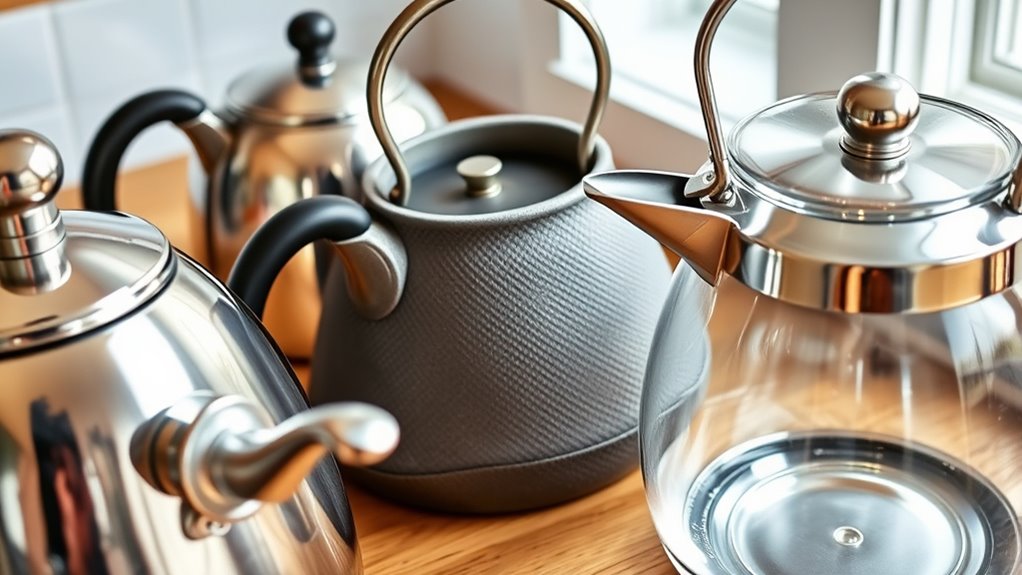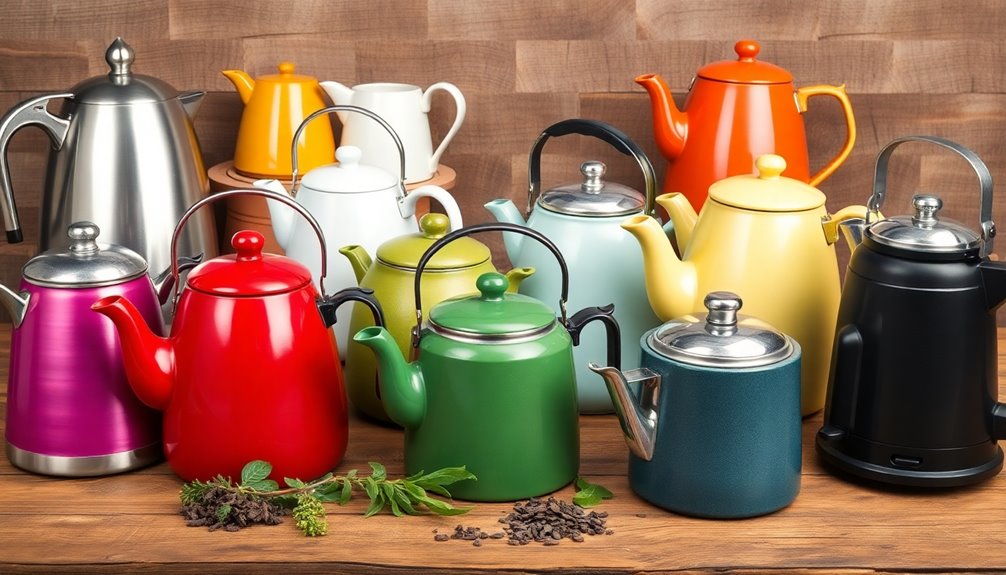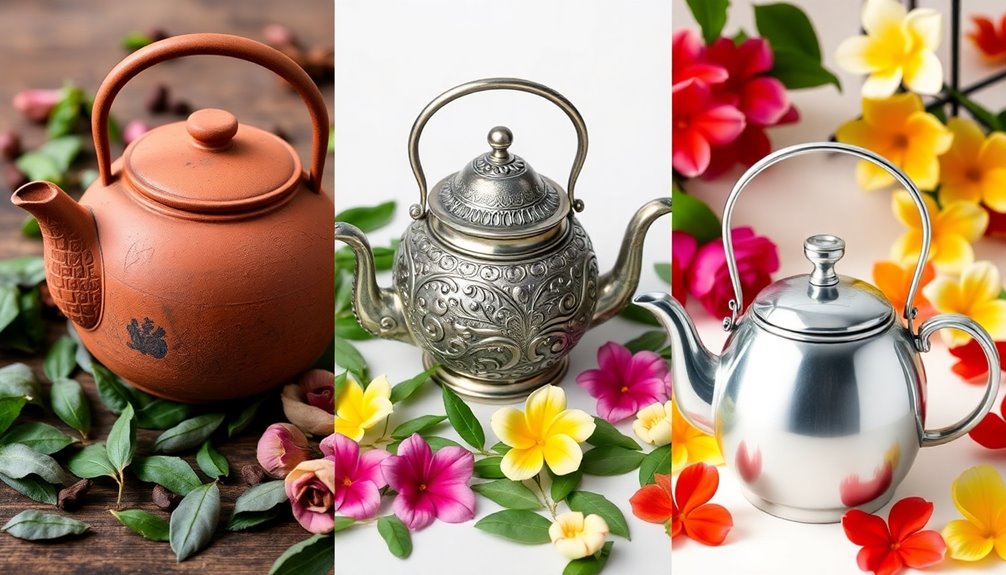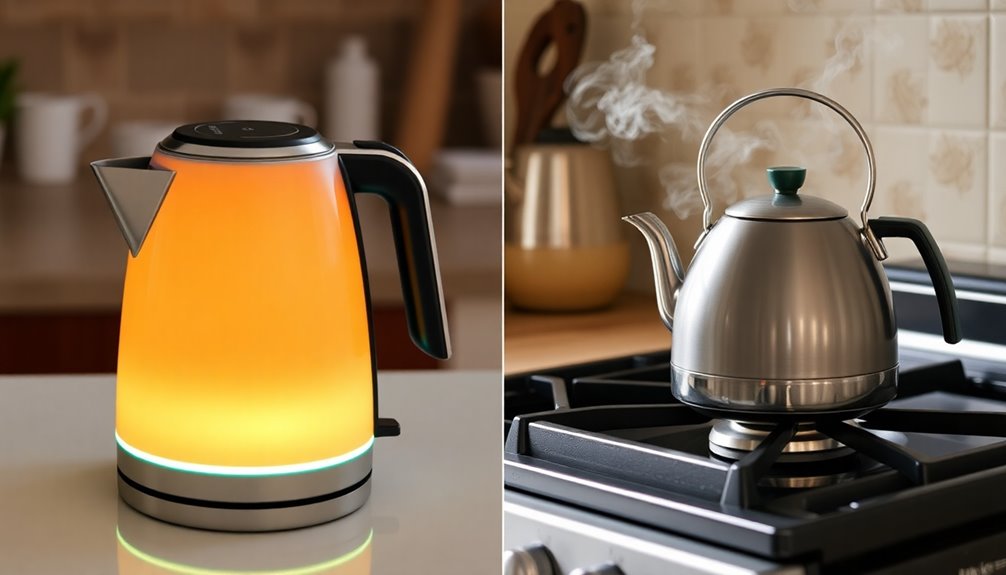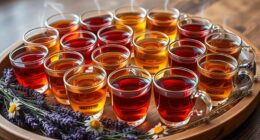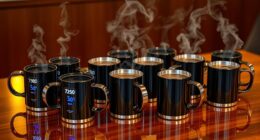When choosing a tea kettle, consider the materials like stainless steel for durability, plastic for lightweight affordability, or glass for visibility. Your heat source matters—electric kettles heat quickly and like compatible materials, while traditional teapots need stove heat. Proper care, such as regular descaling and gentle cleaning, keeps them in top shape and extends their lifespan. To make certain you pick the right one and keep it lasting, you’ll find more helpful tips ahead.
Key Takeaways
- Choose kettle materials like stainless steel for durability, glass for visibility, or ceramic for heat retention based on preferences.
- Match kettle type with heat sources: electric kettles for quick boiling, traditional teapots for stove-top use.
- Regularly descale electric kettles and hand wash traditional teapots to maintain performance and prevent mineral buildup.
- Consider weight, visual appeal, and compatibility with your heat source when selecting a kettle material.
- Proper cleaning and drying extend the lifespan of your kettle and ensure pure-tasting tea.

If you’re looking to make the perfect cup of tea, choosing the right tea kettle is essential. Your choice can influence how quickly your tea brews and how well it retains flavor. Two popular options are electric kettles and traditional teapots—each with its own benefits. Electric kettles heat water rapidly and are incredibly convenient, often featuring adjustable temperatures for different types of tea. They’re perfect if you want a quick, consistent boil with minimal effort. Traditional teapots, on the other hand, usually require a separate heat source like a stove, which might take longer but can add a charming, classic touch to your tea-making routine. They’re often made of materials like ceramic, glass, or metal, each affecting heat retention and aesthetic appeal. When selecting between these options, consider how much control you want over temperature, how quickly you need water heated, and the style you prefer for your tea setup. Additionally, the choice of material can influence the heat retention and overall durability of your kettle. Materials play a significant role in the performance and longevity of your kettle. Electric kettles are typically made of stainless steel, plastic, or glass. Stainless steel models are durable and resist rust, making them suitable for everyday use. Plastic kettles tend to be lightweight and affordable but may not last as long, and some worry about chemical leaching. Glass kettles allow you to see the water as it heats, which is visually appealing and allows you to monitor boiling, but they can be more fragile. Traditional teapots are often crafted from ceramic, cast iron, or glass. Ceramic teapots provide excellent heat retention and a classic look, but they can be heavy and prone to chipping. Cast iron teapots are durable and retain heat well, keeping your tea warm longer, though they require more maintenance. Glass teapots are great for visual appeal and easy cleaning but are fragile. Whichever material you choose, make sure it’s compatible with your heat source and easy to clean. Taking care of your tea kettle is key to ensuring it lasts and continues to perform well. For electric kettles, always follow the manufacturer’s instructions regarding descaling and cleaning. Regularly descale to prevent mineral buildup, especially if you have hard water, and rinse thoroughly after each use. Avoid overfilling to prevent spills and damage to the heating element. Traditional teapots need gentle cleaning—avoid abrasive scrubbers that can scratch delicate surfaces. For ceramic and glass teapots, hand wash with mild soap, and for cast iron, dry thoroughly after each use to prevent rust. When it comes to all types, keep the exterior clean and dry to maintain their appearance. Proper care not only extends the life of your kettle but also ensures your tea tastes fresh and pure every time you brew.
Frequently Asked Questions
How Do I Choose the Best Tea Kettle for My Needs?
When choosing the best tea kettle, you should consider your specific needs. Think about material options like stainless steel, ceramic, or glass, which affect durability and heat retention. Also, evaluate capacity considerations to match your household size or usage frequency. If you often entertain guests, a larger kettle might be ideal. Prioritize ease of use, safety features, and style to find a kettle that suits your lifestyle and preferences perfectly.
Are Electric Kettles Safer Than Stovetop Models?
You might wonder if electric kettles are safer than stovetop models. Electric kettle safety is generally high because they often have automatic shut-off features, reducing the risk of boiling dry or fires. Stovetop kettle risks include overboiling or accidental tipping, which can cause burns or spills. Overall, electric kettles tend to be safer due to built-in safety features, but always follow manufacturer instructions regardless of the type.
Can I Use Non-Stick Kettles for Boiling Water?
You might be tempted to use a non-stick kettle for boiling water, but it’s a case of “don’t judge a book by its cover.” Non-stick durability can vary, and the material safety is key. Some non-stick coatings may release harmful fumes if overheated. So, check the manufacturer’s guidelines first. If it’s designed for boiling water, it should be safe, but always prioritize quality and safety features.
What’S the Best Way to Remove Mineral Buildup?
To remove mineral buildup, you should regularly descale your kettle. Fill it with equal parts water and white vinegar, then bring it to a boil. Let it sit for about 15-20 minutes to dissolve mineral deposits. Afterwards, rinse thoroughly with water to remove any vinegar residue. For tougher buildup, repeat the descaling process or use a commercial descaling product. This keeps your kettle clean and guarantees peak performance.
How Often Should I Replace My Tea Kettle?
You should consider replacing your kettle when it shows signs of wear or mineral buildup that cleaning can’t fix. The kettle lifespan varies depending on material and usage, but generally, a well-maintained kettle lasts about 5 to 10 years. To guarantee safety and performance, check regularly for corrosion, cracks, or persistent mineral deposits. Replacement frequency depends on these factors, so stay attentive to your kettle’s condition to enjoy safe, efficient boiling.
Conclusion
Now that you know about materials, heat sources, and care tips, you’re ready to choose, use, and maintain your perfect tea kettle. Whether you prefer the classic feel of stainless steel, the charm of cast iron, or the efficiency of electric models, your kettle will serve you well with proper care. Embrace the simplicity of boiling water, the joy of brewing tea, and the satisfaction of keeping your kettle in top shape—every step enhances your tea experience.

